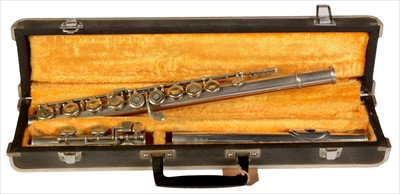

Probably should speak with folks in our local symphony orchestra for ideas! Our music store, such as it is, only deals in new instruments or rentals. Sadly, greatly lacking in my area for locating used altos for sale. I have even located several consignment shops which I have left a message about my interest with. Repairman who handles our son's sax is a wonderful reference also. Don't have definition of "older" though and I have no personal experience to back this up. The 1981 model was 1200.00 then 999.00 and the 1950's model 900.00 though I don't believe I wish one this vintage! Have heard Artley pads are a nusiance to deal with and have also heard older models are better. great deal of quite interesting info here! One thing, the wilkins model is not the same as a Artley 7-0 I also play a artly 7-0 and this flute feels different in fingering. My old teacher told me that you must fall in love with your instrument. Buy a flute or other instrument where you have some feels with it. And the only thing what means is if the flute suits you.

So when you ever have a opportunity to play on a overhauled wilkins flute, do it. And I think when people are talking about instruments they will take over meanings of other posts (including mine perhaps).
ARTLEY FLUTE 212 PROFESSIONAL
But for the one who likes a good made professional flute it is a opportunity to buy a relative cheap second hand flute and make a sound like a powell flute. I know that the market price for this flute is low, I think to low. And it seems that for big hands the flute is more suitable. But this wilkins flute has a lot of potential in tone. I also played muramatsu and other brands. I normally play on a sankyo silver sonic. The body and the applicature feels very solid. My flute is all silver and I think also silver closed holes. The flute has beautiful dark tones in the lower register and the higher register is also colorfull, not sharp. I can tell everyone that my experience with the wiklins model is very very good. They say that the headjoints are bad etc etc. Maybe because the value is not like a powell, muramatsu, sankyo etc. I read on several boards that these flutes are not so good. I want to tell you something about a wilkins flute. You get something, the non-profit gets something, and perhaps a needy students gets something (a flute). That would give you a donation value of perhaps $300-$500 based upon eBay market prices. So, you could get maybe a $100 or so salvage value from the silver, but if you don't want to try to sell it as a flute, rather than scrapping it for salvage value, why not consider donating it to a charitable organization who could themselves sell it in thrift store or perhaps give to a needy family with a child who wants to play flute? Then, you could take a tax deduction for a donation to a non-profit organization. A salvage firm will not pay that much because they have to separate out the non-silver parts and they have to make a profit, so I would guess they would probably pay only about half the selling price of silver, so lets say that comes to $8.50 per ounce. Today, the selling price of silver is about $17 per ounce. Let's assume that the Wilkins is coin silver (since it is not marked as sterling). So the remaining parts of the flute which are silver probably weigh a total of 16 - 3 -1 - 1= 11 or maybe 12 ounces. Of that 16 ounces, there are steel rods (key shafts which may weigh about 2-3 ounces, the head cork probably weighs an ounce or so, and the pads add another ounce. On average, a flute weighs about 1 pound or 16 ounces. So lets calculate the estimated salvage value of the flute. I'm not sure about the silver % in the Wilkins, but it may be coin silver which at best may be 90% silver. Usually (but not always), sterling silver flutes are stamped "Sterling Silver". At best, if it's sterling silver, that is 92.5% silver. However, "solid silver" flutes are not 100% silver. The Artley Wilkins flute is a silver flute (not plated like a student model).


 0 kommentar(er)
0 kommentar(er)
